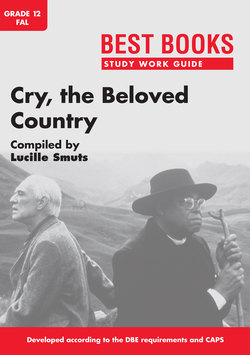Читать книгу Best Books Study Work Guide: Cry, the Beloved Country - Lucille Smuts - Страница 19
На сайте Литреса книга снята с продажи.
3.7 Imagery
ОглавлениеPaton uses simile, metaphor and personification in Cry, the Beloved Country to communicate his message in a creative way.
To do: Study the definitions and examples of simile, metaphor and personification. Then complete the mix-match exercise.
3.7.1 Simile
A simile is a figure of speech that compares two different things; it shows the similarities between them. It is a direct comparison because it uses the words “like” or “as”.
Example: The following example shows the reverberating power of Msimangu’s voice in his sermon to the people of Ezenzeleni. The author compares his voice to different things that the reader knows: “The voice shook and beat and trembled, not as the voice of an old man shakes and beats and trembles, nor as a leaf shakes and beats and trembles, but as a deep bell when it is struck” (p. 78 in your school edition). The sound of his voice is compared to the sound of an old man’s voice, which it is not; to the sound of a shaking leaf, which it is not, and to the sound of a deep bell, which reverberates when it is struck. The repetition of two negative comparisons before the positive comparison increases the impact of the image on the reader.
3.7.2 Metaphor
A metaphor is a figure of speech that makes an implicit, implied or hidden comparison between two things that are unrelated but share some common characteristics.
Example: The author describes the power of John Kumalo’s voice in his public speech about higher wages for the mine workers, after the discovery of gold at Odendaalsrust: “The great bull voice is speaking there in the square” (p. 159 in your school edition). Two unrelated things are compared, a voice and a bull. They have something in common, though: power. A bull is a powerful animal and John Kumalo has a powerful voice.
3.7.3 Personification
It is a figure of speech. The human qualities are given to an object, an idea or an animal.
Example: Reverend Kumalo looks out the window on his journey by train to Johannesburg. He sees the eroded farmlands of the tribes in the Reserve of the Umkomaas River valley: “Here the tribes live, and the soil is sick, almost beyond healing” (p. 12 in your school edition). The soil, which is an object, comes to life because it is described as being ill. A person can become sick, but not the soil of the farmlands.
A person can be healed, but not soil. In Cry, the Beloved Country, nature is viewed as a character because it takes on a deeper meaning throughout the novel in the motif “sickness of the land”, and in the theme of erosion.
Mix-match exercise on imagery
Choose the correct figure of speech in the first column which is used in the quotation in the last column. In each case, write only the symbol (A, B or C) in the middle column.
| Figure of speech | Your answer | Quotation |
| A.Simile | 1.“The water sings over the stones, and the wind cools you.” (p. 50 in your school edition) | |
| B.Metaphor | 2.“There was a change in his voice, it became louder like the voice of a bull or a lion.” (p. 30 in your school edition) | |
| C.Personification | 3.“Then she sat down at his table, and put her head on it, and was silent, with the patient suffering of black women, with the suffering of oxen, with the suffering of any that are mute.” (p. 7 in your school edition) |
